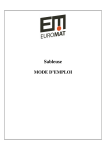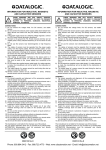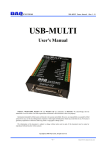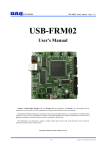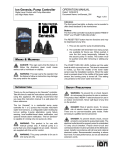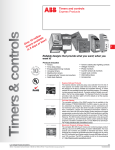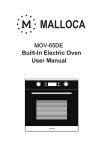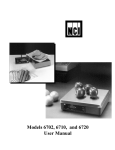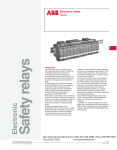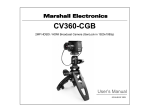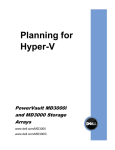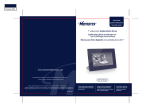Download Personnel Safety And Machine Protection
Transcript
Personnel safety and machine protection Risk category according to EN 954-1 Classification of a machine into categories to EN 954-1 F- Frequency and/or duration of the risk exposure F1 Rare to frequent and/or short duration of exposure F1 Frequent to sustained and/or longduration of exposure P- Options for risk avoidance (Generally referred to the speed and frequency at which the dangerous components moves and to the clearance from the dangerous component). P1 Possible under certain conditions P2 Hardly possible Pursuant to the Machinery Directive 89/393/EEC, every machine must comply with the relevant directives and standards. Measures must be taken to keep the risk to persons below a tolerable extent. In the first step, the project planner performs a risk evaluation to EN 1050 "Risk Assessment". This must take into consideration the machine's ambient conditions for instance. Any overall risk must then be assessed. This risk assessment must be conducted in such a form as to allow documentation of the procedure and the results achieved. The risks, dangers and possible technical measures to reduce risks and dangers must be stipulated in this risk assessment. After stipulating the extent of the risk, the category on the basis of which the safety circuits are to be designed is determined with the aid of EN 954-1 “SafetyRelated Components of Controls”. 7 Categories B This determined category defines the technical requirements applicable to the design of the safety equipment. 1 2 3 4 S1 There are five categories (B, 1, 2, 3 and 4), whereby B (standing for basic category) defines the lowest risk and, thus, also the minimum requirements applicable to the controller. P1 F1 P2 S2 Possible selection of categories pursuant to EN 954-1 Starting point for the risk assessment of the safety-related component of the controller. S- Serious injuries S1 Slight (normally reversible) injuries, S2 Serious (normally irreversible) injuries, including death P1 F2 P2 B1-4 Categories for safety-related components of controls ● ● Preferred category Possible category requiring additional measures Disproportionately extensive measures by comparison with the risk Safety category 1 Summary of requirements System behaviour 2 B The safety-related components of controls and/or their protection devices and their components must be designed, constructed, selected, assembled and combined in compliance with the applicable standards, such that they can withstand the anticipated influences. The occurrence of a fault may lead to loss of the safety function. 1 The requirements of B must be complied with. Time-proven components and time-proven safety principles must be applied. The occurrence of a fault may lead to loss of the safety function but the probability of occurrence is less than in category B. 2 The requirements of B and the use of the time-proven safety principles must be complied with. The safety function must be checked at appropriate intervals by the machine control. • The occurrence of a fault may lead to loss of the safety function between the inspection intervals. • The loss of the safety function is detected by the check/inspection. If the single fault occurs, the safety function is always retained. 3 4 The requirements of B and the use of the time-proven safety principles must be complied with. Safety related components must be designed such that: • a single fault in any of these components does not lead to loss of the safety function and • the individual fault is detected, wherever feasible in an appropriate manner. The requirements of B and the use of the time-proven safety principles must be complied with. Safety related components must be designed such that: • a single fault in any of these components does not lead to loss of the safety function and • the individual fault is detected at or before the next requirement applicable to the safety function or, if this is not possible an accumulation offaults may then not lead to loss of the safety function. Principles for achieving safety Predominantly characterised by selection of componentsl • • • • • Certain faults but not all faults are detected. An accumulation of undetected faults may lead to loss of the safety function. If the faults occur, the safety function is always retained. The faults are detected in good time to prevent loss of the safety function Predominantly characterised by the structure This mandatory classification runs likes a red thread from selection of the smallest limit switch through to the overall concept of the entire machine, whereby it is necessary to grapple with the permanent conflict between what is technically feasible and what is permitted on the basis of “pure theory”. Thus: Depending on application, not every technically feasible safety category is also permitted. For instance, in the case of contactless protection devices (light barriers etc.) only categories 2 or 4 are permitted. By contrast, in the case of tread mats, categories B to 4 can be used, depending on risk assessment, provided these categories can be reached at all owing to the design. The 2-hand control C575 would technically also comply with the lower categories but it cannot be connected in categories 1-3. 1 The categories are not intended to be applied in any specific order or hierarchical arrangements with respect to the technical-safety requirements. 2 The risk assessment will indicate whether full or partial loss of the safety function(s) as the result of fault is acceptable. CTi Automation - Phone: 800.894.0412 - Fax: 208.368.0415 - Web: www.ctiautomation.net - Email: [email protected] Personnel and machine protection Classification of a machine into categories to EN 954-1 Pursuant to the Machinery Directive 89/393/EEC, every machine must comply with the relevant Directives and Standards. Measures must be taken to keep the risk to persons below a tolerable extent. In the first step, the project planner performs a risk evaluation to EN 1050 “Risk Assessment”. This must take into consideration the machine’s ambient conditions for instance. Any overall risk must then be assessed. This risk assessment must be conducted in such a form as to allow documentation of the procedure and the results achieved. The risks, dangers and possible technical measures to reduce risks and dangers must be stipulated in this risk assessment. After stipulating the extent of the risk, the category on the basis of which the safety circuits are to be designed is determined with the aid of EN 954-1 “Safety-Related Components of Controls”. This determined category defines the technical requirements applicable to the design of the safety equipment. There are five categories (B, 1, 2, 3 and 4) whereby B (standing for basic category) defines the lowest risk and, thus, also the minimum requirements applicable to the controller. Possible selection of categories pursuant to EN 954-1 Starting point for risk assessment of the safety-related components of the control. Description Scope of application Potential risks and hazards posed by a machine must be eliminated as quickly as possible in the event of danger. For dangerous movements, the safe state is generally standstill. All safety switching devices of Series C 570 switch to de-energised state, i.e. standstill for drives, in the event of danger or fault. Standard EN 60204 demands that every machine must feature the Stop function of category 0. Stop functions of categories 1 and/or 2 must be provided if necessary for technical-safety and/or technical-function requirements of the machine. Category-0 and category-1 stops must be operable independently of the operating mode, and a category-0 stop must have priority. There are three categories of stop function: Category 0: Shut-down by immediate switch-off of the energy supply to the machine drives. Category 1: Controlled shut-down, whereby the energy supply to the machine drive is retained in order to achieve shut-down and the energy supply is only interrupted when shut-down has been reached. Category 2: A controlled shut-down in which the energy supply to the machine drive is retained. EMERGENCY-STOP EMERGENCY-STOP devices must have priority over all other functions. The energy supplied to the machine drives which may cause dangerous states must be switched off as quickly as possible without further risks or dangers. Resetting of the drives may not trigger a restart. The EMERGENCY-STOP must act either as a stop of category 0 or as a stop of category 1. Low Voltage Products & Systems ABB Inc. • 888-385-1221 • www.abb-control.com The basic device of the 570 Series of safety switching devices can be used for EMERGENCY-STOP applications up to maximum category 4 to EN 954-1. Depending on external wiring and cable routing of the sensors, category 3 resp. 4 to EN 954-1 must be reached. Safety door monitoring Pursuant to EN 1088, a distinction is made between interlocked, separating protective devices and interlocked, separating protective devices with follower. Here as well, the safety switching devices are used for EMERGENCY-STOP applications. Controls up to category 4 to EN 954-1 are possible. Presses and punches The two-hand control C 575 is a device on which the operator must use both hands simultaneously, thus protecting him against risks and dangers. The overtravel monitor C 578 is used on linear-driven presses (e.g. hydraulic, pneumatic and spindle presses) in accordance with VBG7n52. It checks for the following only once during the test stroke: - Correct connection of the operating controls - External cable discontinuity - Possible failure of the components to be monitored cyclically The overtravel monitor can be used only in conjunction with a two-hand control. The press controllers and overtravel monitors are suitable for installation in controls for eccentric, hydraulic and spindle presses. They can be used up to category 4 to EN 954-1. Type III C to DIN 574 is possible specifically for presses. Device construction The safety switching device C 570 operates internally with several contactor relays. The contacts of the relays comply with the requirement in respect of positively driven operation to ZH 1/457, Edition 2, 1978. This means that NO contact and NC contact may not be closed simultaneously. Safety relays with positively driven contacts are used in the newly developed safety switching devices C 571-C 574, C 576, C 577 , the contact expansion C 579 and on the press controllers C 575 and C 578. This series of devices is characterised by an extremely narrow design (22.5mm and 45 mm). Approvals and test certificates, conventional on the market, have been issued by BG, SUVA, UL and CSA. The function of the internal contactor relays/relays is monitored in a redundant circuit. In the event of failure of a relay, the safety switching device always switches to de-energised state. The fault is detected and the safety switching device can no longer be switched on. Using normally closed contacts and normally open contacts for the same function complies with the requirement in respect of diversity. Enable contacts (FK) The safety-related function must be controlled via safe output contacts, the so-called Enable contacts. Enable contacts are always normally open contacts and switch off without delay. Signalling contacts (MK) Normally open contacts and normally closed contacts which may not perform safety-related functions are used as the signalling contact. An Enable contact may also be used as a signalling contact. Delayed Enable contacts Drives which have a long overtravel must be decelerated in the event of danger. For this purpose, the energy supply must be maintained for electrical braking (stop category 1 to EN 60 204-1). The safety switching device C 574 also feature OFF-delayed Enable contacts, besides undelayed Enable contacts. Delay times of 0.5 to 30 s are available. The sealable cover cap C 560.10 (see Selection data and Ordering details, Accessories) can be fitted onto C 574, C 6702 to protect against unauthorised adjustment of the set delay time. Contact expansion If the Enable contacts of the basic device do not suffice, positively driven contactors (e.g. B6, B7) may be used for contact expansion. One solution for increasing the number of Enable contacts, which is both simple to use and space-saving, is the expansion unit C 579 (only 22.5mm wide). The expansion unit C 579 provides 4 additional Enable contacts. Expansion unit C 579 Expansion unit C 579 may not be operated separately in safety-related circuits but must be combined with a safety switching device C 57x. One Enable contact of the basic device is required for connection of an expansion unit. The category of a control with expansion units corresponds to the category of the basic device. Mounting Snap-on mounting on 35mm top-hat rail to EN 50 022. Screw mounting of the safety switching devices C 57x can be implemented with two additional plug-in tabs C 560.20 (see Selection data and Ordering details, Accessories). User Manual A User Manual with a device description, connection diagrams and application information in several languages is enclosed with every safety switching devices of Series C 570 and C 67xx. “Safety Engineering” Application Manual You can find further information in the “Safety Engineering” Application Manual. It provides you with the required information on the relevant safety standards and project planning information. The entire range of components used for safety applications is explained in this Manual, from the sensor (Emergency-Stop command devices and position switches), through evaluation units (safety switching devices C 57x and fail-safe control AC 31 S) to the actuator (e.g. contactor for switching motors). All these components must be selected correctly in order to meet the requirements applicable to modern safety facilities. Please order the “Safety Engineering” Application Manual 1SAC 103 201 H 0101 German 1SAC 103 201 H 0201 English 7.55 1SXU 000 023 C0201 CTi Automation - Phone: 800.894.0412 - Fax: 208.368.0415 - Web: www.ctiautomation.net - Email: [email protected] 7



